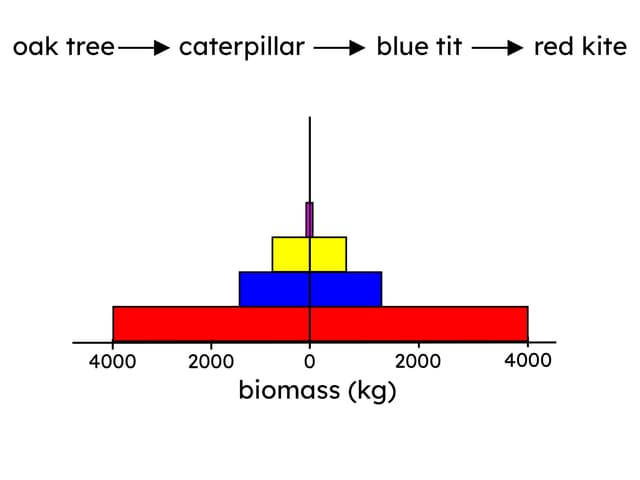Starter quiz
 Look at the food chain diagram below. Name the producer.
Look at the food chain diagram below. Name the producer.- algae ✓
- shrimp
- cod
- seal
- polar bear
-
 Look at the food web diagram. What type of organism is the triggerfish?
Look at the food web diagram. What type of organism is the triggerfish?- It is a primary consumer.
- It is a producer.
- It is a secondary consumer.
- It is both a primary and a secondary consumer. ✓
- It is a tertiary consumer.
-
 How many apex predators are there in this food web and what organisms are they?
How many apex predators are there in this food web and what organisms are they?- One - tiger shark
- Two - phytoplankton and seaweed
- Two - tiger shark and tuna ✓
- Three - mantaray, pufferfish and triggerfish
- There are no apex predators in this food web
-
- What word describes the amount of living material found in one or more organisms?
- 'biomass' ✓
 Which option correctly matches the predator to the prey, based on the food web below?
Which option correctly matches the predator to the prey, based on the food web below?- The owl is the predator and the ladybird is the prey.
- The spider is the predator and the aphid is the prey.
- The stoat is the predator and the bramble is the prey.
- The vole is the predator and the moth larva is the prey. ✓
- The aphid is the predator and the bramble is the prey.
-
 The diagram below shows a food chain. If the number of ladybirds decreases due to disease, what will happen to the numbers of other organisms in the food chain?
The diagram below shows a food chain. If the number of ladybirds decreases due to disease, what will happen to the numbers of other organisms in the food chain?- Potatoes, aphids and swifts will increase.
- Potatoes and swifts will increase, whereas aphids will decrease.
- Potatoes, aphids and swifts will decrease.
- Potatoes and swifts will decrease, whereas aphids will increase. ✓
-
Exit quiz
 Look at the food chain diagram below. Match the organism to the correct trophic level it occupies.
Look at the food chain diagram below. Match the organism to the correct trophic level it occupies.- algae⇔producer ✓
- shrimp⇔primary consumer ✓
- cod⇔secondary consumer ✓
- seal⇔tertiary consumer ✓
- polar bear⇔quaternary consumer ✓
 Look at the pyramid of biomass. What can you tell from the pyramid of biomass?
Look at the pyramid of biomass. What can you tell from the pyramid of biomass?- The number of organisms increases as you move along the food chain.
- The number of organisms decreases as you move along the food chain.
- The biomass decreases as you move along the food chain. ✓
- The biomass increases as you move along the food chain.
-
- In food chains, biomass can be lost between different trophic levels. One example is when food that is eaten is not digested. The undigested food is released from the body. What is the release called?
- excretion
- indigestion
- egestion ✓
- decomposition
-
- Food chains show how food (biomass) is transferred from one organism to another. Most food chains contain five trophic levels or less. Why are food chains not longer than this?
- Organisms get larger at higher trophic levels.
- Biomass is lost at each trophic level. ✓
- There are more organisms consuming biomass at higher trophic levels.
- Producers are consumed before they make enough biomass.
-
- How much of something (e.g. biomass) is transferred compared to how much is available is known as what?
- 'efficiency' ✓
 Look at the table of biomasses of organisms that could be found in a food chain diagram. What is the approximate percentage efficiency of biomass transfer between each trophic level?
Look at the table of biomasses of organisms that could be found in a food chain diagram. What is the approximate percentage efficiency of biomass transfer between each trophic level?- 100%
- 50%
- 10% ✓
- 1%
- 0.1%
-
Worksheet
Presentation
Video
Lesson Details
Key learning points
- All food chains start with a producer that makes the biomass that is transferred to consumers in higher trophic levels.
- Not all biomass from a trophic level is passed to the next one (due to respiration, uneaten parts, egestion, excretion).
- Pyramids of biomass are scaled diagrams that can be used to show the amount of biomass present at each trophic level.
- % efficiency of biomass transfer = (biomass in higher trophic level ÷ biomass in lower trophic level) × 100
- How efficiency of biomass transfer affects the number of organisms in higher trophic levels.
Common misconception
A misconception that is often seen is that there is a build up of biomass along a food chain.
The lesson outlines how biomass is actually lost between trophic levels through life processes.
Keywords
Producer - A producer is an organism that makes its own food.
Biomass - Biomass is the mass of living material in one or more organisms.
Trophic level - A trophic level is the position of an organism in a food chain diagram.
Pyramid of biomass - A pyramid of biomass is a diagram which shows the biological mass (biomass) of organisms at each trophic level in a food chain diagram.
Efficiency - The efficiency is how much of something is transferred compared to how much is available, e.g. how much biomass is transferred to a consumer compared to how much is available.